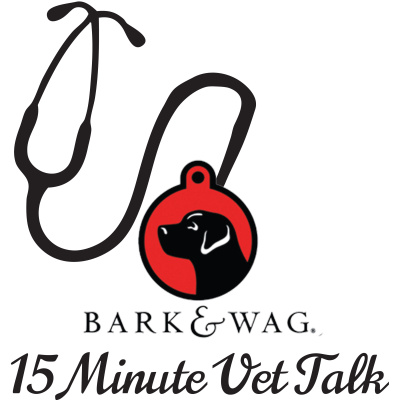Sinopsis
Each week Bark & Wag will interview Veterinarians and individuals in the pet industry from across the nation answering your questions about your pet. Visit barknwag.com/podcast to ask questions and view past podcasts.
Episodios
-
Dog training tips to keep you positive with your pooch with Trainer Kersti Nieto
20/02/2017 Duración: 11minWelcome to Bark & Wag 15 Minute Vet Talk – I am your host Polly ReQua Today we are talking to Kersti Nieto, trainer at Dog Training Camp USA in Raleigh, NC on what to do when you become frustrated with your dog and dog training. Things are not going as plan - what do you do? COUNT TO TEN In these moments it’s critical that I don’t let my temper get the best of me, because my dog is going to associate that anger and negative energy with being introduced to stranger dogs. The solution? Rather than fume, I count as I remove my dog and I from the situation. I count to ten. TAKE DEEP BREATHS While we’re counting and moving ourselves into a safer place, I’m also taking deep breaths. A natural response to stress is to tense up, but if you want your dog to return to being relaxed, you’ve got to return to that relaxed state too! Breath deeply as you count, until you don’t feel like a rubber band that’s ready to snap. Sometimes I also take a moment to stretch or sit down. SHIFT YOUR FOCUS Letting go of those pri
-
What are rabies and how do you protect your dog from getting this disease?
18/02/2017 Duración: 11minRabies is a severe, and often fatal, viral polioencephalitis that specifically affects the gray matter of the dog's brain and its central nervous system (CNS). The primary way the rabies virus is transmitted to dogs in the United States is through a bite from a disease carrier: foxes, raccoons, skunks, and bats. Infectious virus particles are retained in a rabid animal's salivary glands to better disseminate the virus through their saliva. Once the virus enters the dog's body, it replicates in the cells of the muscles, and then spreads to the closest nerve fibers, including all peripheral, sensory and motor nerves, traveling from there to the CNS via fluid within the nerves. The virus can take up to a month to develop, but once the symptoms have begun, the virus progresses rapidly. This inflammatory infection also has zoonotic characteristics and can therefore be transmitted to humans. If you would like to learn more about how this disease affects cats, please visit this page in the petMD health library.
-
Need a behaviorist for your dog that is counter surfing?
10/02/2017 Duración: 12minWelcome to Bark & Wag 15 Minute Vet Talk – I am your host Polly ReQua Today we are talking to Kersti Nieto, trainer at Dog Training Camp USA in Raleigh, NC about tips on how to find a dog trainer. Here are some frequently asked questions from pet parents who are seeking professional behavioral help for their pet: What are the differences between pet-behavior professionals? Trainers Pet trainers use a number of different titles, such as “behavior counselor,” “pet psychologist” and “pet therapist.” The level of education and experience among this group of professionals varies greatly. Most learn how to work with animals through apprenticeships with established trainers, volunteering at animal shelters, attending seminars on training and behavior and training their own animals. And some are certified by specialized training schools. Certified Professional Dog Trainers (CPDTs) The Certification Council for Professional Dog Trainers (CCPDT), an independent organization created by the Association of Professiona
-
What is Canine Hip Dysplasia and how do you protect your dog?
29/01/2017 Duración: 13minYou are listening to Bark & Wag’s 15 Minute Vet Talk and I am your host Polly ReQua Today we are talking with Dr. Susan McMillan, owner of Vet to Pet Mobile Veterinary Service in Burlington, Vermont about Canine Hip Dysplasia. What is it and how do we protect our dogs? Canine Hip Dysplasia in Dogs The hip joint is composed of the ball and the socket. The development of hip dysplasia is determined by an interaction of genetic and environmental factors, though there is a complicated pattern of inheritance for this disorder, with multiple genes involved. Hip dysplasia is the failure of the hip joints to develop normally (known as malformation), gradually deteriorating and leading to loss of function of the hip joints. Hip dysplasia is one of the most common skeletal diseases seen in dogs. Gender does not seem to be a factor, but some breeds are more likely to have the genetic predisposition for hip dysplasia than other breeds. Large and giant breeds are most commonly affected, including the Great Dane, Sai
-
Thank you for a great 2016! Here is to a successful 2017!
18/01/2017 Duración: 44sBark & Wag would like to thank you for being a subscriber. We have lots of interviews planned in 2017 to keep you informed. We are grateful for your support.
-
Is your dog a swimmer? How to use Essential Oils to prevent ear infections.
08/01/2017 Duración: 07minYou are listening to Bark & Wag’s 15 Minute Vet Talk and I am your host Polly ReQua Today we are talking with Sara DeTienne, Essential Oils Representative about ear infections and how Essential Oils can help. Maddie, our Black Lab, is a big swimmer and I would love to be proactive with her ears and use oils before an infection starts. How can Essential Oils help? Canine ear infections are most often caused by bacteria or yeast overgrowth. Ear mites, growing hair, trapped water, tumor or foreign body in the ear canal can also lead to an overgrowth of bacteria or yeast. Infections may also develop when allergies, immune system disorders, hypothyroidism or an excessive amount of ear wax are present. Frequent bathing, swimming and using incorrect cleansing methods can also lead to infections. Because a dog’s ear canals plunge downward then horizontally from the ear opening, it is difficult for caught debris or water to be released as it must work it’s way upward to escape this makes dogs especially suscep
-
Ready to party like a rock star and your pooch eats all of your pot before you ring in the new year? What to do?
31/12/2016 Duración: 10minBottom line after talking to a few Veterinarians - they do not care what drugs you are taking, they want to save the dog. Get the dog to your Vet. Symptoms to look out for: Severe depression Walking drunk Lethargy Coma Low heart rate Low blood pressure Respiratory depression Dilated pupils Coma Hyperactivity Vocalization Seizures
-
Keep your BFF safe over the Holidays with these tips.....
24/12/2016 Duración: 15minWelcome to Bark & Wag 15 Minute Vet Talk – I am your host Polly ReQua Today we are talking to one of our favorite Vets, Dr. Laura Brown, owner of Green Tree Animal Hospital in Libertyville, IL on how to keep your pets safe during the Holiday season. Holiday Safety Tips for Your Pets The holidays can be an exciting time of year for you and your pet, but they also pose hidden hazards for your furry friends. And nothing can spoil good cheer like an emergency trip to the veterinarian. This holiday season, learn to recognize common pet hazards so you can take extra precautions to keep your pets safe, healthy and happy. Dangerous Décor and Holiday Treats From chocolate and yeast dough to ornaments and plants, seasonal and everyday items can go from joyful to dreadful in a matter of seconds. Follow these pet-proofing steps to avoid common holiday health risks: Hang holiday lights and ornaments out of reach. Pets can get shocked if they bite through the wires — and ornaments can be a choking hazard. Secure yo
-
Are you thinking of a new pet for the Holidays? Why a Rescue and Shelter pet is your best bet for a new BFF!
18/12/2016 Duración: 13minYou are listening to Bark & Wag’s 15 Minute Vet Talk and I am your host Polly ReQua. Today we are talking with Dr. Susan McMillan, owner of Vet to Pet Mobile Veterinary Service in Burlington, Vermont to shed light on shelter dogs. With somewhere between 5 and 7 million homeless animals entering U.S. animal shelters, it’s unconscionable to suggest, as one writer did in the Washington Post, that adopting a pet from an animal shelter is a bad idea. (See a comprehensive refutation from Washington Humane Society’s Lisa Lafontaine.) But as ridiculous as anti-shelter arguments are, they reveal destructive myths about shelter animals that need to be called out every time they arise. I’m sharing some of the most persistent ones below, and have enlisted help from ASPCA shelter science experts to help dispel them. Myth: The major reasons dogs end up in shelters is because they were seized in criminal cases, or were too aggressive to own safely. More than half of all dogs and cats in shelters were received as strays
-
Are you allergic to dogs? How about a chicken as a pet?
07/12/2016 Duración: 08minToday we talk to Kari Fisher, chicken flock owner, about owning chickens as pets.
-
Gross! My dog is scooting! What are anal glands?
22/11/2016 Duración: 13minToday we talk to Dr. Laura, owner of GreenTree Animal Hospital, in Libertyville, IL on the gross topic of anal glands. You may not think of that dog in your bed as a predator, but at heart, he is. And like all predators, your dog has anal sacs (anal glands) located on both sides and slightly below his anus. They produce fluid with a distinctive odor that identifies him and tells other dogs his sex, approximate age, health status, and other things. Healthy anal glands express, or empty, this fluid when the dog has a bowel movement. Unfortunately, some anal glands don’t work as they should because of inherited malformations, or because of a history of poor-quality foods that produce poor-quality bowel movements. If the anal glands don’t empty properly, they can become impacted, making bowel movements difficult or painful, and potentially leading to infections or abscesses. It’s not uncommon for a rescued dog to have a history of anal gland problems. Your dog may damage the delicate tissue around his anus in hi
-
Does your dog ever have a reverse sneezing attack? What is it? What can we do to help our dogs?
14/11/2016 Duración: 04minWelcome to Bark & Wag 15 Minute Vet Talk – I am your host Polly ReQua Today we are talking to one of our favorite Vets, Dr. Laura Brown, owner of Green Tree Animal Hospital in Libertyville, IL as we discuss reverse sneezing. Dogs have a condition we call a 'reverse sneeze.' It may also be known as a 'pharyngeal gag reflex'. It is termed a reverse sneeze, because it sounds like the dog is rapidly pulling air into his nose, whereas in a 'regular' sneeze, the air is rapidly pushed out through the nose. During a reverse sneeze, the dog will make rapid and long inspirations, stand still, and extend his head. A loud snorting sound is produced, which may make you think the dog has something caught in his nose. The most common cause of a reverse sneeze is irritation of the soft palate, which results in a spasm. This spasm narrows the airway and makes it temporarily more difficult for the dog to take in air. Factors that may be associated with reverse sneezing include excitement, eating or drinking, exer
-
Does your dog have separation anxiety? How can we help our pets?
07/11/2016 Duración: 09minWelcome to Bark & Wag 15 Minute Vet Talk – I am your host Polly ReQua Today we are talking to Robyn Santor, owner of Spirit Dog Training in Fairfax, VT as we discuss separation anxiety. Recently, my mom rescued a Golden Retriever who has severe separation anxiety. I wanted to bring Robyn on the podcast to discuss why pets gets separation anxiety and what we can do to help our pets. Welcome Robyn One of the most common complaints of pet parents is that their dogs are disruptive or destructive when left alone. Their dogs might urinate, defecate, bark, howl, chew, dig or try to escape. Although these problems often indicate that a dog needs to be taught polite house manners, they can also be symptoms of distress. When a dog’s problems are accompanied by other distress behaviors, such as drooling and showing anxiety when his pet parents prepare to leave the house, they aren’t evidence that the dog isn’t house trained or doesn’t know which toys are his to chew. Instead, they are indications that the dog has se
-
Veterinarians tips on protecting your dogs nose and paws this winter.
30/10/2016 Duración: 07minToday we are talking to one of our favorite Veterinarians, Dr. Laura Brown, Owner of Green Tree Animal Hospital, in Libertyville, IL as we discuss how to protect your Prince or Princess from the harsh winter. Tips on protection for paws and noses. One of the biggest threats to healthy paw pads is the salt used to melt ice on driveways, roads and sidewalks. Prolonged contact can lead to chemical burns on dog paws. If your dog is limping by end of a walk, deicing products may be hurting his feet. Try to keep your dog off the salty sidewalk (think grass or snow) whenever possible. Another threat from deicers is ingestion. Dogs may lick their paws or your boots and ingest deicing salts. To prevent your dog from ingesting deicing salts, keep a shallow bowl of warm water and a cloth near the entryway to your home so that you can wipe your boots and your dog’s paws when coming back inside. Another common cause of sore paws during the cold winter months are the ice balls which form between the pads and toes of hairy-
-
Does your dog counter surf? We need to correct that annoying habit.
24/10/2016 Duración: 07minWelcome to Bark & Wag 15 Minute Vet Talk – I am your host Polly ReQua Today we are talking to Robyn Santor, owner of Spirit Dog Training in Fairfax, VT as we discuss counter surfing. Learn tips on breaking this bad habit.
-
Gross...your dog has fleas! How do dogs get fleas and how do you get rid of them?
08/10/2016 Duración: 14minYou are listening to Bark & Wag’s 15 Minute Vet Talk and I am your host Polly ReQua Today we are talking with Dr. Susan McMillan, owner of Vet to Pet Mobile Veterinary Service in Burlington, Vermont to learn more about fleas. How do dogs get fleas? What do they look like? And how do you prevent fleas. Welcome Susan…. How Do Dogs Get Fleas? Dogs can catch fleas just about anywhere. Here are some of the most common ways your dog can pick up these pests. Is your pup a walking flea magnet? In order to stop future infestation, you’ll need to track down how your pet contracts these bloodsuckers in the first place. Here are the four most common ways dogs get fleas. DOGS GET FLEAS FROM OTHER ANIMALS Dogs’ social nature may work against them when it comes to flea control. The most likely way your pet will come in contact with fleas is through exposure from other animals. Fleas can easily jump onto your dog from carriers in close range and start up a new colony. So which flea-infested animals are a danger to your
-
Bark & Wag 15 Minute Vet Talk
18/09/2016 Duración: 08minWelcome to Bark & Wag 15 Minute Vet Talk – I am your host Polly ReQua Today we are talking to Carey and Adam Brown, Owner of Simple Oil Girl and Simple Oil Guy, from Bend, Oregon. We are going to discuss oils for pets. I wanted to interview Carey to discuss what are oils for pets, how do you use the oils and what type of issues can you treat with oils? Welcome Carey and Adam..... Just as aromatherapy can benefit humans both physically and psychologically, it can also benefit dogs. It is important to remember that the essential oils blends and aromatherapy that human beings can handle and enjoy, might not produce the same reaction in our pets. In fact, some oils can be quite dangerous. Dr. Richard Palmquist has the following to say about essential oils and your dog: “Oils have been shown to have many possible desirable effects such as reducing anxiety and inflammation, fighting oxidative processes, battling toxins and fighting infections by inhibiting bacteria, fungi and viruses. Oil odors can also be use
-
Bark & Wag 15 Minute Vet Talk
02/09/2016 Duración: 10minDoes your dog have Arthritis? Today we talk to Dr. Susan McMillan, owner of Vet to Pet Mobile Veterinary Service in Burlington, Vermont about the symptoms of Arthritis. Effects of Arthritis – From the Dog’s Point of View Arthritis is a painful, progressive, usually permanent joint disease that unfortunately is common in domestic dogs. While it is most commonly seen in older dogs, arthritis can also strike younger animals, especially those with a genetic predisposition to developing the disease. Arthritic dogs experience varying degrees of stiffness, soreness, lameness and pain in one or more affected joints. They feel worse when they get up in the morning or try to stand after taking a nap. Cold, damp weather can increase their discomfort. Because arthritis is almost always irreversible, most arthritic dogs get more painful as time passes. In severe cases, this condition can become debilitating and even crippling. Symptoms of Arthritis – What the Owner Sees The clinical signs of canine arthritis usually appe
-
Bark & Wag 15 Minute Vet Talk
26/08/2016 Duración: 08minWelcome to Bark & Wag 15 Minute Vet Talk – I am your host Polly ReQua Today we are talking to one of our favorite Veterinarians, Dr. Laura Brown, owner of Green Tree Animal Hospital in Libertyville, IL as we discuss what to do if your dog is quilled by a porcupine? Porcupines Porcupines are most active at night, but may be found foraging for food during the day, too. They have poor eyesight, but a great sense of smell. They are herbivores - eating plants, twigs, leaves and bark. Fond of salt, they may gnaw on bones or approach areas inhabited by humans for this mineral. There are 29 species of porcupines around the world, and they are one of the largest members of the rodent (rodentia) family. Their habitat ranges from grasslands, to forests, to deserts. Quills are off-white and black and are made out of keratin. Up to 30,000 quills cover the average porcupine. 2. Quills Quills have very tiny one-way barbs along the shaft of the quill. This make is easy for quiils to keep moving... inward! Qui
-
Bark & Wag 15 Minute Vet Talk
14/08/2016 Duración: 12minWelcome to Bark & Wag 15 minute Vet Talk – I am your host Polly ReQua Today we are talking to one of our favorite vets, Dr. Susan McMillan, owner of Vet to Pet Mobile Veterinary Service in Burlington, Vermont as we discuss puppy socialization. How to Socialize Your Puppy One of the most valuable lessons you can teach your puppy is that the world is a safe place, with kind humans and friendly dogs and other animals. The act of exposing your puppy to the world is called socialization. Many puppy owners have heard that this is important but really don’t know how to go about doing it correctly. If you do it right, you’ll help your puppy grow up to be confident and outgoing. If it’s done wrong, you can inadvertently create a frightened, aggressive puppy. A critical time for your puppy’s learning is from birth to 16 weeks of age. During this time, puppies can absorb a great deal of information, but they are also very vulnerable to bad experiences. Puppies who are not properly exposed to different ty














